Remote Desktop is a feature to access as well as control another system from a distance. To access the Linux Mint desktop from another computer, use remote desktop software to do so. xrdp is a remote desktop server that uses the RDP (Remote Desktop Protocol) which is widely used by different operating systems (Ubuntu, Windows, Linux Mint, etc.). It connects to your Linux Mint computer from another device using different clients.
xrdp allows users to connect to your Linux Mint desktop from any RDP-compatible client such as Windows Remote Desktop Connection, macOS Microsoft Remote Desktop, or Linux Remote Desktop. It is valuable for several tasks, e.g. technical support, remote work, file sharing, and more.
This guide will explain the instructions to install as well as set up the remote desktops on Linux Mint based on supported content:
- How to Install and Setup Remote Desktop on Linux Mint? (From Windows to Linux)
- Alternative 1: Install/Setup 2D Desktop Environment on Linux Mint (From Windows to Linux)
- Alternative 2: Setup xrdp With X11VNC on Linux Mint (From Windows to Linux)
- Alternative 3: Setup Remote Desktop on Linux Mint (From Linux to Linux)
- Alternative 4: Setup Remote Desktop on Linux Mint (From Mac to Linux)
- Bonus Tip: Other Tools to Setup Remote Desktop on Linux Mint
How to Install and Setup Remote Desktop on Linux Mint? (From Windows to Linux)
Multiple remote desktops “xrdp”, “Remmina”, and “Vinagre” are known on the Linux Mint for making remote connections. The most popular and easy-to-use remote desktops, “xrdp” and “Remmina” are considered in this guide.
To install and setup “xrdp” (remote desktop server) on Linux Mint, and establish the connection to it from multiple devices. Let’s follow the below instructions:
Step 1: Update System Repository
First of all, open a Linux Mint terminal and update the system package list (repository). It updates the system package and is ready to install any package in the operating system. For this, run the “update” command with “APT” package manager:
sudo apt update

Step 2: Install XRDP (Remote Desktop Server)
To install and configure the XRDP (remote desktop server) on Linux Mint, use the “xrdp” command with the “install” utility. It installs xrdp and its dependencies on the system:
sudo apt install xrdp

Users may be asked to enter the root password and confirm the installation.
Step 3: Check XRDP Services
Once the installation is complete, xrdp starts automatically and listens for incoming connections on port “3389” (by default). To confirm its services, check the current status of the “xrdp” service via the “systemctl” utility:
sudo systemctl status xrdp

In the output, the “active (running)” means that xrdp is running and ready to accept connections.
If users see “inactive (dead)” or “failed”, it means that xrdp is not operating or has faced an error. For this, try to restart xrdp by entering the “systemctl” command with the “sudo” privileges:
sudo systemctl restart xrdp

Note: By default, the service is enabled, and “xrdp” is running. If you still see an error, check the log file of xrdp by entering the following command:
sudo journalctl -u xrdp

It shows messages that xrdp has logged since it started. Users can look for any errors or warnings that may indicate what is wrong with xrdp.
If the services occur same error, then start as well as enable “XRDP” by executing the below script:
sudo systemctl start xrdp # start xrdp sudo systemctl enable xrdp # enable xrdp

Step 4: Get the System IP Address
Now, find the IP address by entering the “ip” command with the “a” utility in Linux Mint terminal:
ip a

The IP address of Linux Mint is “192.168.157.143” after “inet“ in the line that starts with “ens33” network interface (or a similar name).
Most Important: After getting the IP address, users must “log out” of the current working system such as Linux Mint (in our case). Otherwise, the remote desktop cannot listen to the system and causes errors.
Step 5: Make a Remote Desktop Connection (From Windows)
If you are using a Windows computer (as a client), use the built-in “Remote Desktop Connection” software to connect to xrdp. Then, enter the IP address, “username” as well as the “password” of the Linux Mint (server machine) to make the remote connection.
Let’s follow the below instructions for practical experience:
5.1: Open Remote Desktop Connection
First of all, find “Remote Desktop Connection” in the search box. Then, choose the “Open” option in the extended list to launch the application (built-in):

5.2: Provide IP Address (Server Machine)
In the pop-up interface, type the IP address of your Linux Mint system (server machine) in the “Computer” text box. After that, click the “Connect” button to make the remote connection:

It generates pop-up windows. At there, hit the “Yes” button for further procedure:

5.3: Provide Username and Password (Server Machine)
Enter the “username” (server machine) as well as the “password” (server machine) of the Linux Mint. In our case, the username is “linuxmint”. Finally, press the “OK” button:

5.4: Verification
Now, login to the Linux Mint (server machine) via the Remote desktop connection of Windows (client machine):

This guide has explained the way to install as well as set up a remote desktop in detailed instructions on Linux Mint.
Alternative 1: Install/Setup 2D Desktop Environment on Linux Mint (From Windows to Linux)
If you have a 3D desktop environment or “Cinnamon”, “GNOME”, or “KDE”, then users may face some errors during remote connection establishment. To resolve it, follow the below instructions:
Step 1: Install XFCE
To install the XFCE on the operating system, run the “xfce4” command with the “apt” command:
sudo apt install xfce4

Step 2: Integrate Remote Desktop
The remote desktop utilizes the specific desktop environment (pre-installed). To integrate with different desktops, first, set up the remote desktop. To do so, run the below script:
echo xfce4-session >~/.xsession

Step 3: Restart RDP (Remote Desktop) Service
To restart the remote desktop service, users need to use the “systemctl” command to restart the “xrdp” services, execute the below command:
sudo systemctl restart xrdp

Now, reboot the system and choose the 2D Desktop environment named “Xfce Session” in the dropdown window:

Step 4: Verification
After launching this new desktop environment, users can verify its interface:

That is all from this section of the new desktop environment. Now, users can establish a remote connection by following the above procedure of Windows.
Alternative 2: Setup xrdp With X11VNC on Linux Mint (From Windows to Linux)
By default, xrdp uses the “Xorg” display server to create a new session for each remote connection. This means that you will not see your existing desktop when you connect to xrdp, but a new one with a different configuration and appearance.
If users need to see your existing desktop when you connect to xrdp, change the display server from “Xorg” to “X11VNC”. Then, follow the below instructions:
Step 1: Install X11VNC
X11VNC is software that allows you to share your existing X11 display over a network. To use X11VNC with xrdp, install it first by entering the following command:
sudo apt install x11vnc

It installs X11VNC and its dependent packages on the Linux Mint.
Step 2: Create a Password for X11VNC
Next, users need to create a password for X11VNC by entering the “storepasswd” command below:
x11vnc -storepasswd

This prompts users to enter and confirm a password for X11VNC. It stores this information in “.vnc/passwd” in the home directory.
Step 3: Edit Configuration File of xrdp
Now, onwards users need to edit the configuration file of xrdp by mentioning the “/etc/xrdp/xrdp.ini” file name:
sudo nano /etc/xrdp/xrdp.ini
It opens the file in a nano text editor. Then, search the portion that starts with [Xorg]. You need to comment out this section by adding a semicolon (;) at the start of every line:

Next, move downward until you find the portion that starts with [Xvnc]. Uncomment this section by removing the semicolon (;) at the beginning of each line. After that, change the port from “-1 to 5900”, and the password based on user requirement:

Next, you need to save and exit the file by pressing the “CTRL+O” key, then Enter, and then “CTRL+X”.
Step 4: Restart xrdp Services
Now, users need to restart xrdp services by entering the “restart” command:
sudo systemctl restart xrdp

It applies the changes that users perform to the configuration file.
Step 5: Access Remote Desktop (From Windows to Linux)
Now, xrdp will use “X11VNC” to share your existing desktop when you connect to it.

It displays the same desktop that you see on your monitor, with the same configuration and appearance. If not working, users can use the “Xorg” session from the list and connect to the removed desktop.
Step 6: Log Out from Remote Desktop
To log out from the Linux Mint (server machine), hit the “Menu” icon and select the “Log Out” option from the list in the Windows interface of “Remote Desktop Connection”:

Then, click on the “Log Out” button:

Alternatively, users can disconnect the connection using the “close” button present at the top right corner of the window. It pops up warning instructions, reads them, and follows them:

That is all from the installation and configuration of the remote desktop on Linux Mint.
Alternative 3: Setup Remote Desktop on Linux Mint (From Linux to Linux)
One way to set up a remote desktop from Linux Mint to another Linux distribution (Ubuntu) is to use the “remmina” package. This package allows users to connect to a remote desktop session using the RDP protocol.
In “remmina” (Remote Desktop Client), click on the “+” icon, select RDP as the protocol, and enter the server IP address, username, and password of the remote machine. Finally, press the “Save and Connect” button to make/start the remote desktop session.
Step 1: Install Remmina
To connect to the Ubuntu machine from Linux Mint, users need to install an RDP client such as “Remmina” (Remote Desktop Client). To install Remmina on Linux Mint, users need to run the command:
sudo apt install remmina

Step 2: Launch Remmina
To launch the “Remmina” remote desktop on Linux Mint, execute the “remmina” command in the terminal. To create a new connection, click on the “+” icon and follow the below instructions:
remmina

Step 3: Enter Information (Server Machine)
Now, select RDP as the protocol, and enter the server IP address or hostname of the Ubuntu machine, username and password, and any other settings you want. Finally, click on the “Save and Connect” button to start the remote desktop session:

Step 4: Login to Server Machine (From Linux to Linux)
Now, a new interface for remote connection to the Ubuntu system. In this interface, type the username and password of the “Ubuntu” server machine and press the “OK” button. In our case, the username is “linux” as below:

Step 5: Verification
Now, users can confirm that the Ubuntu machine is remotely accessed on the Linux Mint with the highlighted IP address:

Note: If the user faces some issue/error during setup of the remote desktop, go to the “Settings” window, open the “Sharing” option from the sidebar, and “ON” the “Sharing” toggle button and the “Remote Desktop” utility/option. It enables the Ubuntu system to make remote connections to other operating systems (e.g. Linux Mint):

Step 6: Disconnect Remote Connection
Finally, users can close the Remote Desktop Connection window by pressing the “X” button of the “Quick Connect” tab or logging out from the Linux Mint desktop to end the connection:

Note: Users can also make a remote connection using “SSH” by following the guide on “Enable SSH on Ubuntu”.
Alternative 4: Setup Remote Desktop on Linux Mint (From Mac to Linux)
If you are using a macOS computer, use the “Microsoft Remote Desktop” software to connect to xrdp. For this, follow these steps:
Step 1: Install Microsoft Remote Desktop
First of all, users need to download as well as install Microsoft Remote Desktop that comes from the App Store.

Step 2: Add Remote PC Information
Open Microsoft Remote Desktop and click on the “+” icon at the top. Then, select “Add PC” from the menu:

In the “Add PC” interface, type the name of the Linux Mint system in the “PC name” text field. Then, hit the “Add” button that pops up the new interface:

In the “Add a User Account” window, enter your “Username” and “Password” for your Linux Mint computer in the “Username” and “Password” fields. Press the “Add” button to save the user account:

Note: Users can click on “Add again” to save the PC.
Step 3: Make a Remote Connection (From Mac to Linux)
Finally, see the Linux Mint computer listed in Microsoft Remote Desktop. Double-press on it to establish the connection:

It takes some time to establish a remote desktop connection.
Step 4: Verification
Finally, users can verify the remote desktop connection from the Mac to Linux by matching the “IP address” as below:

In this way, all possible methods (Windows to Linux, Linux to Linux, and Mac to Linux) have been provided.
Bonus Tip: Other Tools to Setup Remote Desktop on Linux Mint
Remote Desktop helps someone else troubleshoot their Linux Mint system, or collaborate on a project. There are different third-party tools to set up remote desktops on Linux Mint, such as “VNC”, “TeamViewer”, “AnyDesk” and a lot more.
- The VNC remote desktop server uses the VNC protocol. To establish the remote connection using VNC, follow our guide Setup VNC on Linux Mint.
- To install and configure TeamViewer (a cross-platform remote desktop software that uses its proprietary protocol), explore our guide on Install and Setup TeamViewer.
- To configure AnyDesk (cross-platform remote desktop software), navigate to our detailed guide on Install and Setup AnyDesk.
Conclusion
Remote Desktop is a useful tool that allows users to access and control the Linux Mint computer from another device. To install/setup a remote desktop on it, install “xrdp” using the apt command on the Linux Mint terminal. Then, restart the xrdp service and check its status. Finally, connect to your Linux Mint computer from another device using a Remote Desktop client. Enjoy the remote session, and remember to disconnect when you are done.
Another way to setup a remote desktop on Linux Mint from Linux and Windows, use the “remmina” and “Remote Desktop Connection” (built-in), applications, respectively. In addition, users can configure the “xrdp.ini” file to enable encryption and authentication. This guide has explained several ways to install as well as set up a remote desktop on a Linux Mint machine.
Comprehensive Guide to Setting Up xRDP on Linux Mint
This guide provides a complete, step-by-step process for installing and configuring xRDP on Linux Mint to allow you to connect to your Linux desktop remotely using the Remote Desktop Protocol (RDP). The steps here include configuring the desktop session to avoid common issues with the Cinnamon desktop environment.
Installation and Basic Configuration
-
Update the system package repositories:
sudo apt update && sudo apt upgrade -
Install xRDP and necessary dependencies:
sudo apt install xrdp xorgxrdp -y
-
Enable xRDP to start on boot and verify its status:
sudo systemctl enable xrdp sudo systemctl status xrdp -
Configure the firewall to allow RDP connections:
Desktop Environment Configuration
-
Create the proper
.xsessionfile to fix issues with the Cinnamon desktop:echo "cinnamon-session" > ~/.xsession
-
Make the
.xsessionfile executable (critical step): -
Restart the xRDP service to apply the changes:
sudo systemctl restart xrdp
Verification and Connection
-
Find your Linux Mint machine’s IP address:
-
Restart your computer to ensure that all changes take effect:
Connecting from Windows
- Open Remote Desktop Connection (mstsc.exe).
- Enter your Linux Mint machine’s IP address.
- Click Connect and enter your Linux username and password when prompted.
Important Notes and Troubleshooting
-
Session Management: You must log out of your local GUI session before connecting via RDP. Leave the Linux Mint machine at the login screen for successful remote connections.
-
Multiple Sessions: Unlike Windows RDP, you cannot have multiple active RDP sessions simultaneously. Disconnect from your current session before connecting from another device.
-
Desktop Environment: This guide is specifically for the Cinnamon desktop environment. For other desktops, adjust step 5 accordingly.
-
If the Desktop Crashes After Login: The
~/.xsessionfile is key to resolving this issue. Use «cinnamon-session» instead of «cinnamon-session-cinnamon» for better compatibility across various Linux Mint versions. -
Display Issues: If you encounter display problems (missing icons, wrong theme colors), make sure your
~/.xsessionfile contains exactly «cinnamon-session» and that it is executable. -
Alternative Solution: For a system-wide configuration rather than per-user, you can edit
/etc/xrdp/startwm.shand replace the last two lines withcinnamon-session.
Advanced Configuration (Optional)
For more detailed xRDP configuration, you can edit its configuration file:
sudo nano /etc/xrdp/xrdp.ini
Common settings to modify include:
max_bpp: color depth (16, 24, 32)port: default is 3389security_layer: RDP security level
Save the changes and restart xRDP after modifications.
Now you should be able to remotely access your Linux Mint machine via RDP from Windows or other systems with an RDP client.
Do your want to access Windows 7, 10, or 11 using Remote Desktop protocol on Linux Mint? Then here is the tutorial to install Remmina RDP on Mint.
Access Windows 10/11 using RDP from Linux Mint1. Run system update2. Install Remmina on Linux Mint 203. Run Remmina4. Use RDP to access Windows 7/10/115. Windows remote desktop on Linux Mint via RDP
Remmina is a lightweight software that can be easily installed on Linux operating system. It allows Linux users to establish Remote desktop connection access to Windows computers using the RDP protocol. However, apart from RDP it also supports VNC, NX, XDMCP, and SFTP protocols. It is possible to route a connection through an SSH tunnel, which is particularly useful if you normally want to use unencrypted protocols such as VNC over the Internet. In addition, VNC connections can be set up in reverse (“reverse”) if, for example, the server is behind a NAT router.
This tutorial is not limited to Windows 10 or 11, you can use XP, Vista, Windows servers because all of them come with RDP. Moreover, the steps given for Linux Mint here are also applicable for Ubuntu, Elementary OS, MX Linux, POP! OS, and other similar OS.
1. Run system update
On your Linux Mint press CTRL+ALT+T keyboard shortcut to access the command terminal and then run the system update command:
sudo apt update
2. Install Remmina on Linux Mint 20
The Remmina is already available in the base repository of Linux Mint, thus, we don’t need to add any extra repository at all. Simply in your command terminal run:
sudo apt install remmina
3. Run Remmina
After the installation, the program can be started from the Application launcher. Go to the Linux Mint Start button and search for Remmina, as its icon appear, click to run the same.
4. Use RDP to access Windows 7/10/11
Now, from the Remmina interface select the RDP protocol and then type the IP address of the Windows system that you want to access remotely on Linux Mint. After that hit the Enter key.

5. Windows remote desktop on Linux Mint via RDP
Finally, once the connection is established you will see a window asking you to enter the username and password of the remote system. After that, you will have your remote Windows system’s display on your Linux Mint PC to access it.
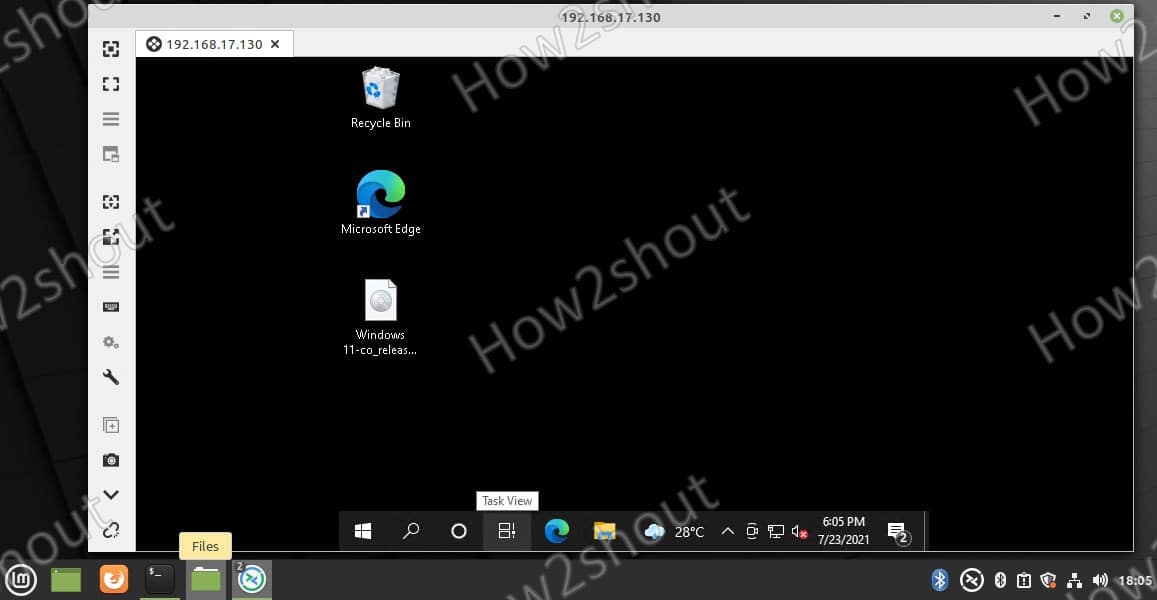
In this way, we can access Windows PC, laptop, or server on Linux mint using the remote desktop protocol.
Other Articles:
♦ How to install and configure VNC Server on CentOS 8
♦ Install Teamviewer on Ubuntu 20.04 via Terminal
♦ krdc: Access Windows 10 from Ubuntu 20.04 KDE RDP
Все способы:
- Используем RDP-клиенты в Linux
- Вариант 1: Remmina
- Вариант 2: rdesktop
- Вариант 3: freerdp
- Вопросы и ответы: 3
Технология RDP (Remote Desktop Protocol) позволяет пользователям одинаковых или разных версий операционных систем совершать удаленное управление компьютером. Существуют специальные клиенты, отличимые от консольных утилит, где эта опция реализована через графический интерфейс, а это значит, что юзеру предоставляется полный вид рабочего стола, возможность взаимодействовать с клавиатурой и указателем мыши. В рамках сегодняшней статьи мы хотим рассказать об использовании популярных RDP-клиентов в Linux.
Используем RDP-клиенты в Linux
Сейчас существует не так много RDP-клиентов, поскольку имеются сложности в реализации технологии, которые связаны и с ее проприетарностью. Однако обычному юзеру на выбор предлагается не менее трех различных вариантов. Далее мы хотим рассказать лишь о самых популярных и надежных из них, а вы, отталкиваясь от инструкций, уже сможете инсталлировать подходящий клиент и производить подключение к серверу.
Вариант 1: Remmina
Remmina — самый популярный клиент удаленного рабочего стола, который по умолчанию предустановлен во многих дистрибутивах Linux. Однако зачастую его версия является устаревшей. Эта программа имеет простой и понятный GUI с огромным количеством вспомогательных инструментов. Освоить ее сможет даже начинающий пользователь, поэтому мы и поместили этот софт на первое место. Давайте пошагово разберем процедуру установки, настройки и подключения в Remmina.
Шаг 1: Установка
Начать следует с установки данного RDP-клиента в операционную систему. Как было сказано ранее, по умолчанию во многих дистрибутивах Remmina уже присутствует, но не помешает обновить ее версию, что не займет много времени.
- Если в вашей системе Remmina попросту отсутствует и вы хотите инсталлировать стабильную, но не самую последнюю сборку, для начала запустите «Терминал» удобным способом, например, через меню приложений или зажав комбинацию Ctrl + Alt + T.
- В открывшейся консоли введите
sudo apt install remminaи нажмите на Enter. Замените пакетный менеджер apt на другой, если используете дистрибутив, основанный на RedHat или Fedora. - Всегда действия инсталляции запускаются от имени суперпользователя, поэтому приходится подтверждать их, вводя пароль в новой строке. Эта ситуация не стала исключением.
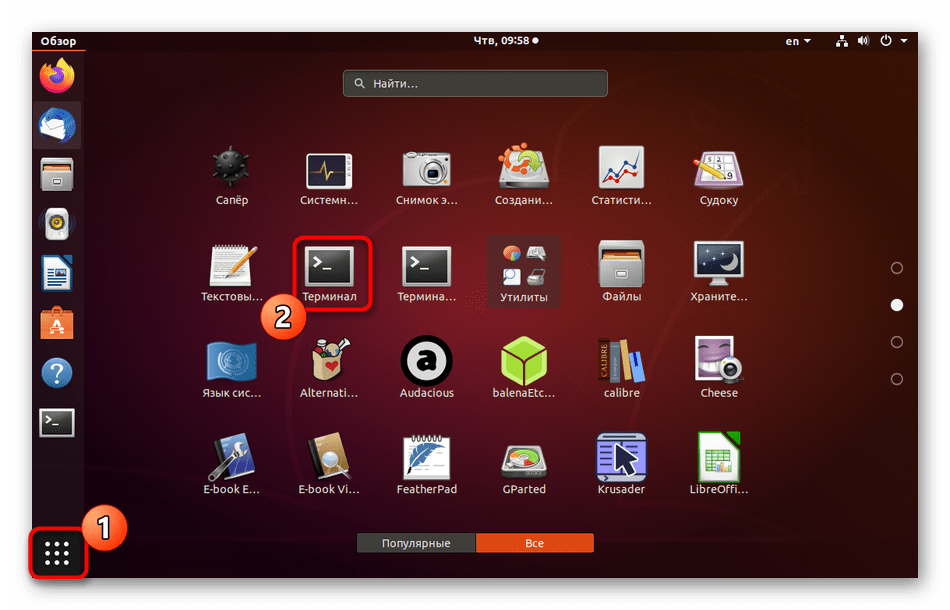
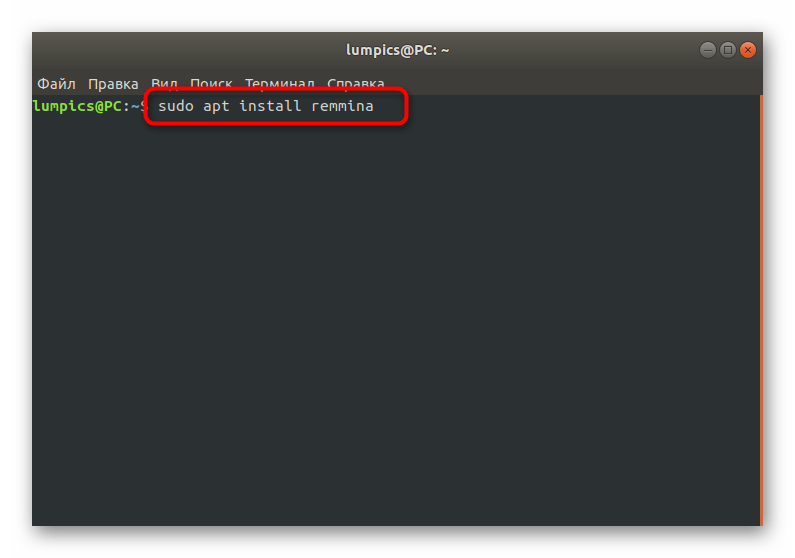

Далее может потребоваться дополнительное подтверждение расширения занятого дискового пространства. После успешного завершения инсталляции можно переходить к использованию клиента. Если же вы желаете обновить версию, придется задействовать пользовательские хранилища, поскольку на официальные новые сборки не поступают. Реализация будет немного сложнее, а выглядит так:
- В консоли введите
sudo apt-add-repository ppa:remmina-ppa-team/remmina-next, чтобы получить файлы из хранилища. - Подтвердите это действие, написав пароль учетной записи суперпользователя.
- Вы будете уведомлены о получаемых пакетах. Примите их, нажав на Enter.
- Ожидайте завершения скачивания файлов. Во время этой операции не закрывайте консоль и не прерывайте соединение с интернетом.
- После этого следует обновить список системных хранилищ через команду
sudo apt-get update. - Остается только произвести инсталляцию RDP-клиента и сопутствующих ему плагинов, введя
sudo apt-get install remmina remmina-plugin-rdp libfreerdp-plugins-standard. - Подтвердите информацию о занимаемом дисковом пространстве, выбрав ответ Д, и дожидайтесь окончания процедуры.
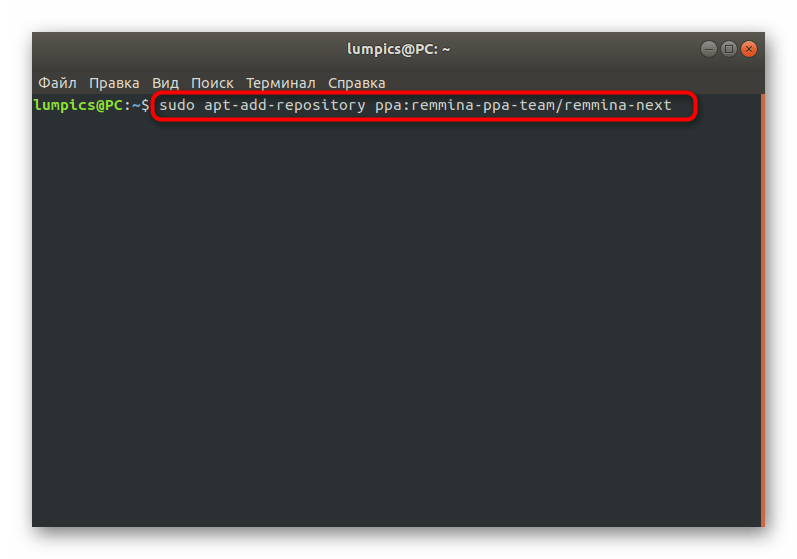
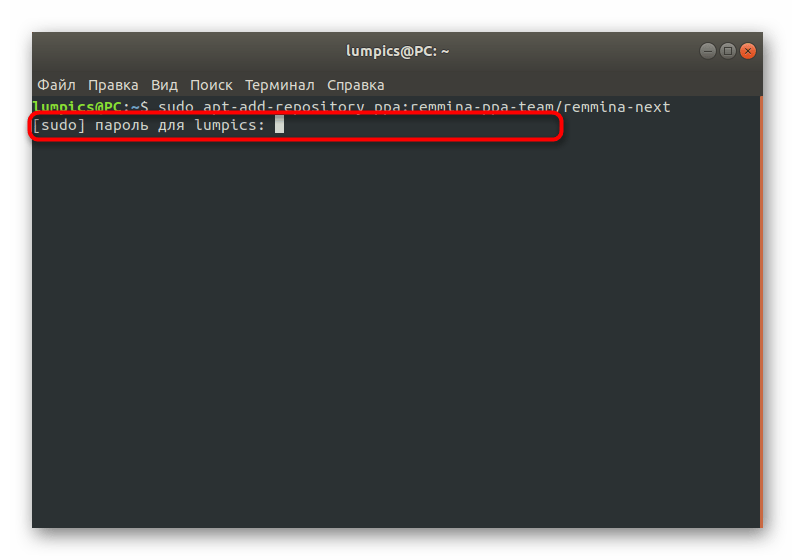
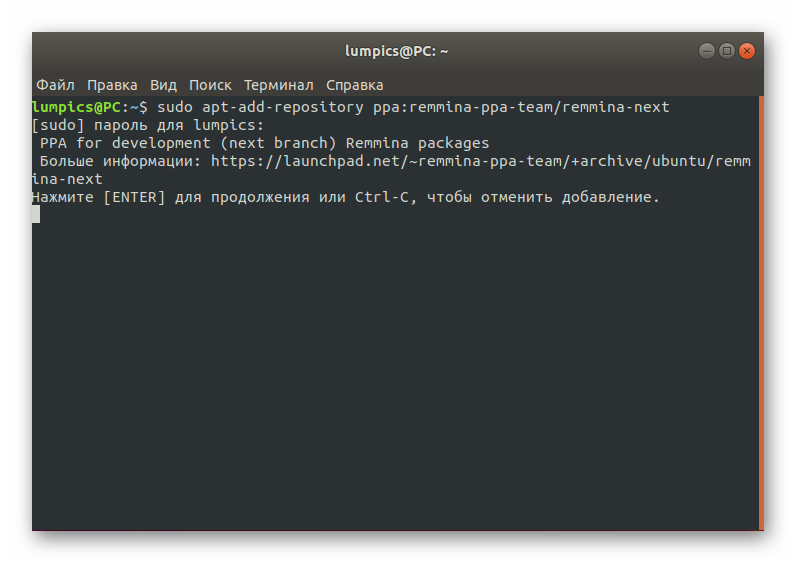

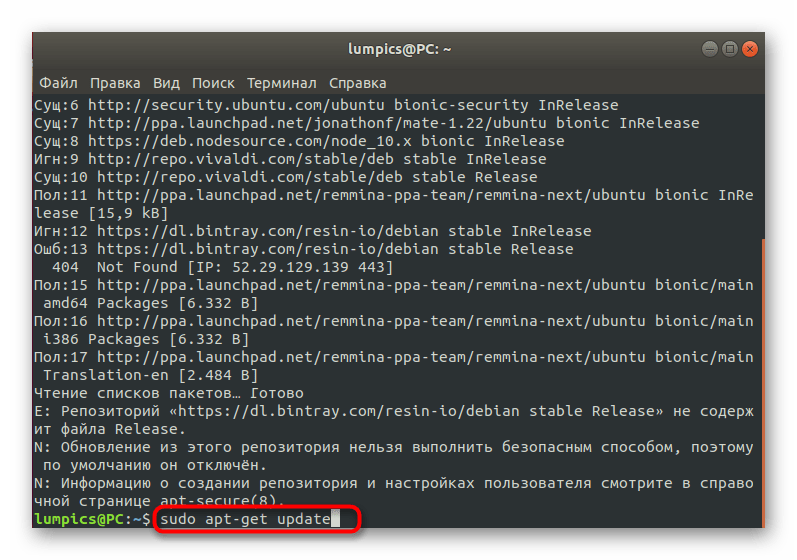
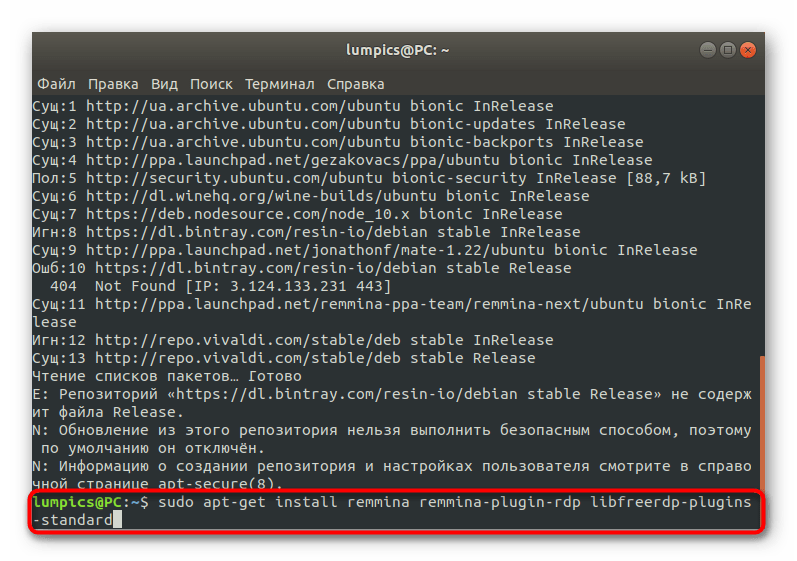
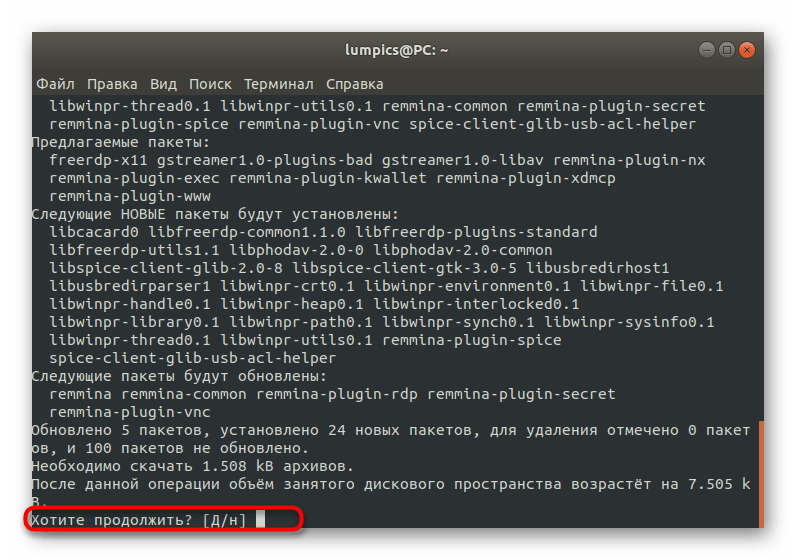
На этом инсталляция Remmina завершена. Старая версия будет автоматически замещена новой, следовательно, можно закрывать консоль и переходить к первому запуску программного обеспечения.
Шаг 2: Запуск и настройка
С запуском и конфигурацией Remmina разберется даже самый начинающий пользователь, а с последним поможет официальная документация. Однако мы все же хотим остановиться на основных моментах, чтобы при реализации этой задачи не возникло каких-либо трудностей.
- По умолчанию значок Remmina сразу же после установки будет добавлен в меню приложений. Отыщите его там, прокрутив список или воспользовавшись строкой поиска.
- Для перехода к настройкам кликните по кнопке в виде трех горизонтальных линий и выберите пункт «Параметры».
- Теперь на экране отобразится окно «Настройки Remmina». В нем присутствует огромное количество вкладок, отвечающих за внесения глобальных и пользовательских изменений. Например, здесь можно задать стандартное разрешение экрана, изменить комбинации клавиш, редактировать пункты протокола SSH и безопасности.
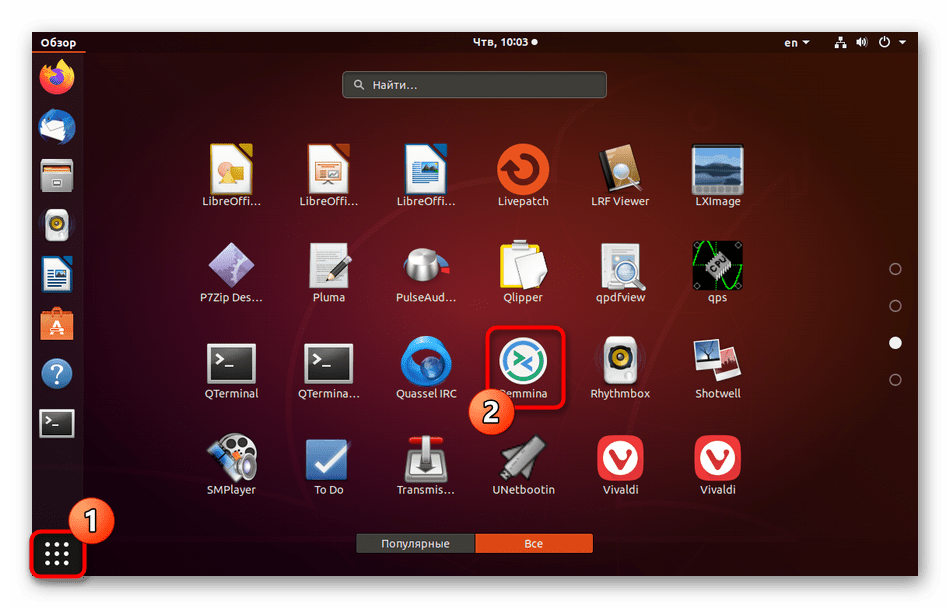
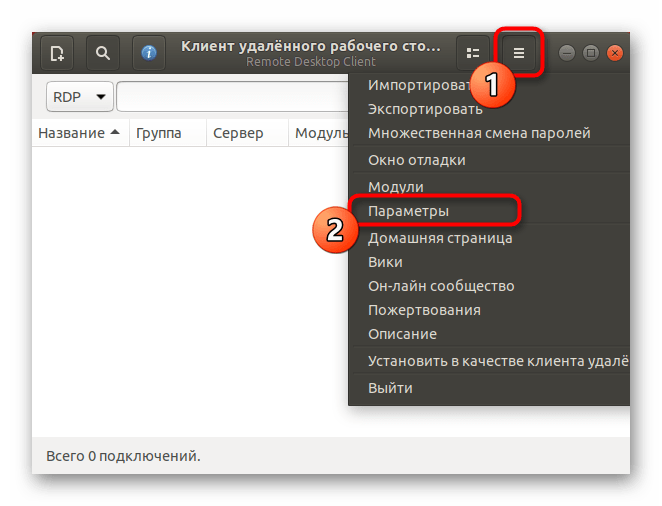

Мы не будем останавливаться на каждом присутствующем пункте детально, поскольку разработчики предоставляют официальную информацию по каждой опции, а также интерфейс Remmina имеет русский язык, что поможет самостоятельно во всем разобраться.
Шаг 3: Создание профиля и подключение
После установки оптимальной конфигурации Remmina остается только создать профиль для подключения, используя рассматриваемый протокол, чтобы успешно соединиться с удаленным рабочим столом. Мы предлагаем разобрать основной принцип этой процедуры.
- Найдите на верхней панели соответствующий значок и кликните по нему левой кнопкой мыши, чтобы отобразилась форма создания подключения.
- Заполните все строки в соответствии со своими требованиями. Обязательно перепроверяйте данные учетных записей и адреса серверов. После этого вы можете выбрать действие. Если нажать на «Подключить», указанные настройки сохранены не будут, ведь для этого следует кликнуть на «Сохранить и подключить».
- В будущем сохраненные профили можно запускать прямо через главное меню Remmina. Все доступные подключения отобразятся в виде таблицы с детальной информацией.
- После запуска откроется отдельное окно с виртуальным рабочим столом. Ожидайте начала загрузки и используйте инструменты на левой панели, чтобы управлять сеансом.
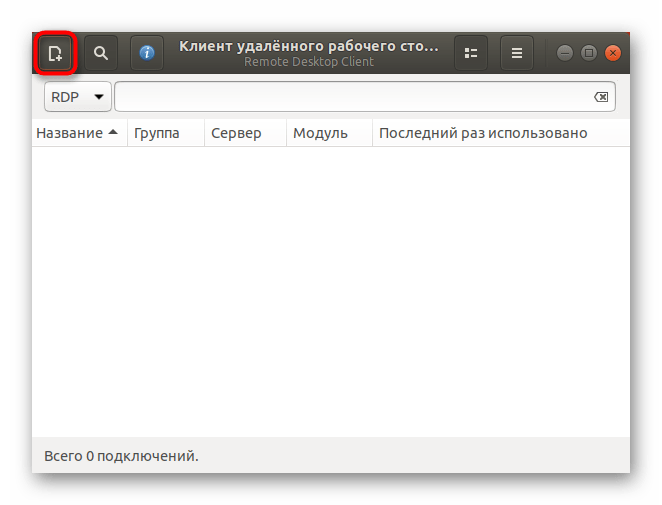
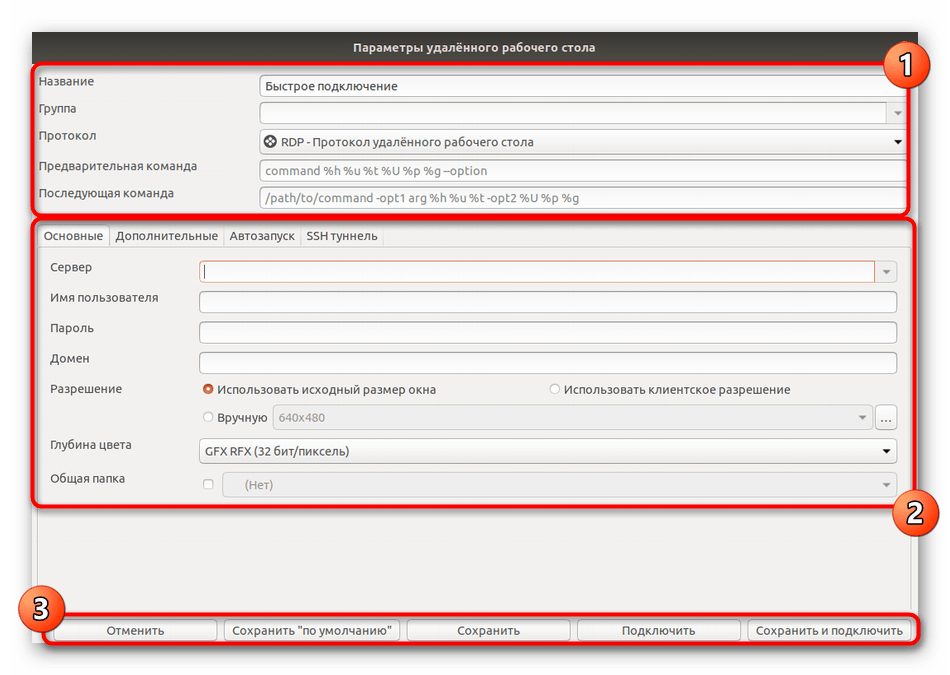
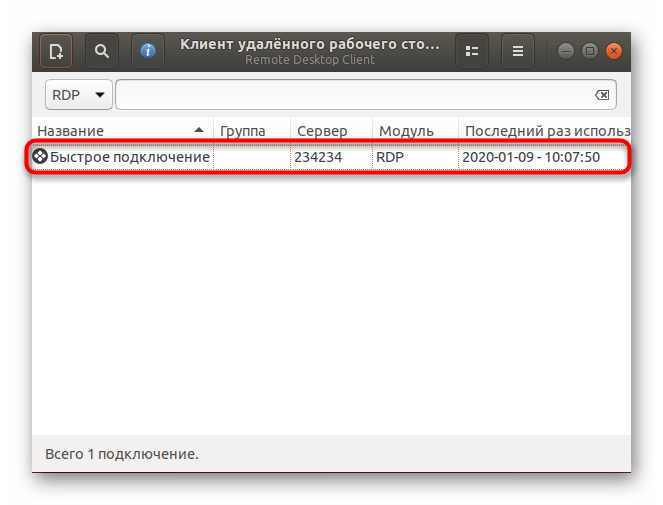
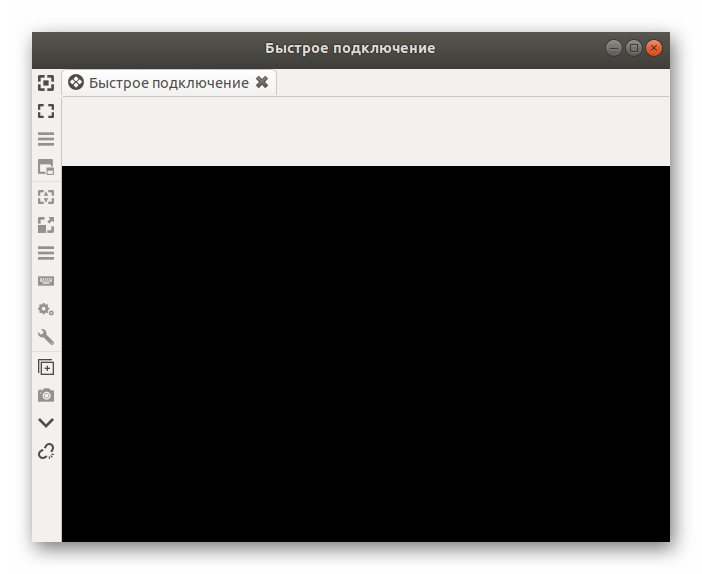
Теперь остается только приступить к взаимодействию с удаленным рабочим столом, выполняя там необходимые действия. Если у вас возникли какие-то вопросы по управлению Remmina, обратите особое внимание на документацию: там в максимально развернутом виде описаны ответы абсолютно на все вопросы пользователей.
Вариант 2: rdesktop
Следующий инструмент под названием rdesktop не является таким популярным среди начинающих пользователей, поскольку все настройки производятся через консоль путем ввода соответствующих команд. Однако это решение стало востребованным среди профессионалов и любителей консольных утилит.
Шаг 1: Установка rdesktop
Вкратце остановимся на самой процедуре инсталляции rdesktop. Данная программа доступа в официальных хранилищах дистрибутивов, благодаря чему юзеру не потребуется скачивать дополнительные файлы или пакеты.
- Откройте «Терминал» любым удобным образом.
- Введите команду
sudo apt-get install rdesktopи нажмите на Enter. - Подтвердите это действие, введя пароль суперпользователя в новой строке.
- Установка будет продолжена сразу же после выбора положительного ответа «Д».
- Запуск данной утилиты тоже осуществляется через «Терминал» через команду
rdesktop.
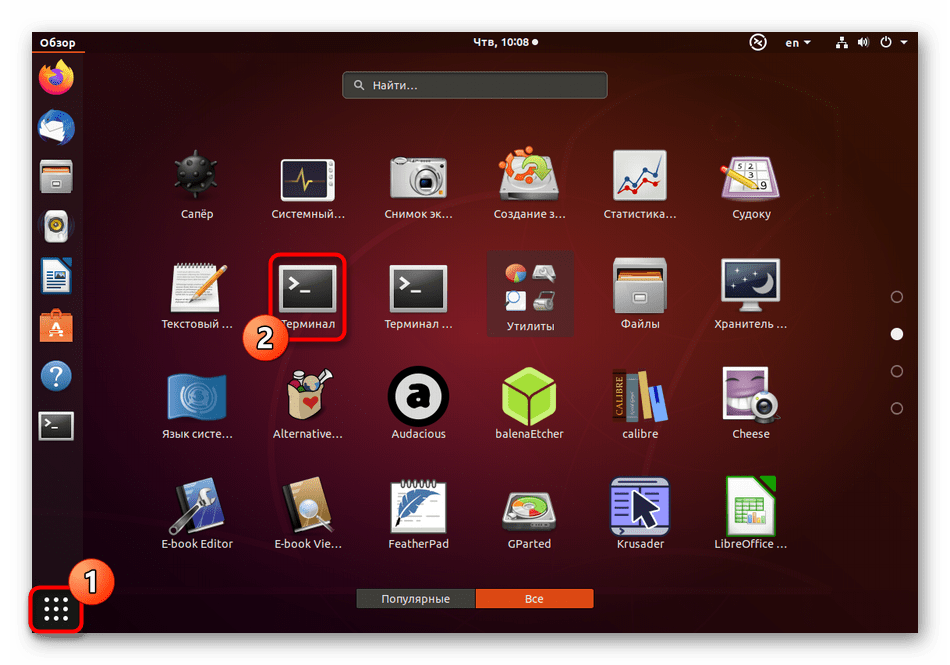
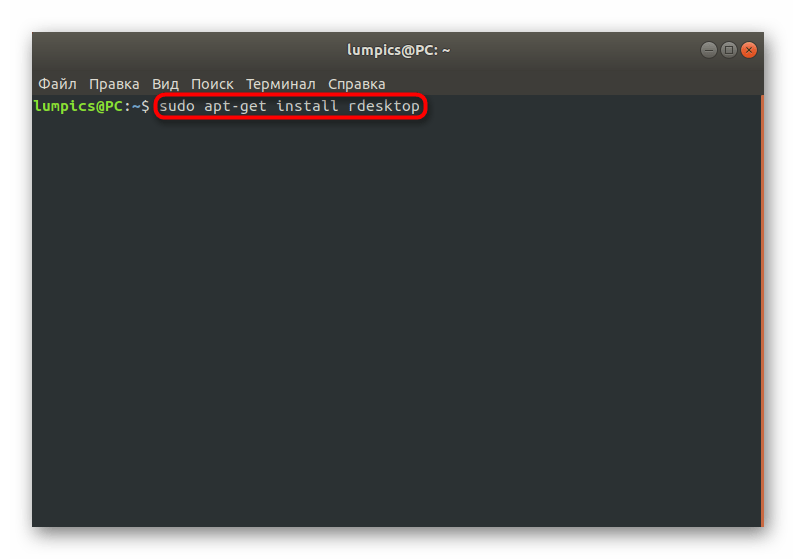
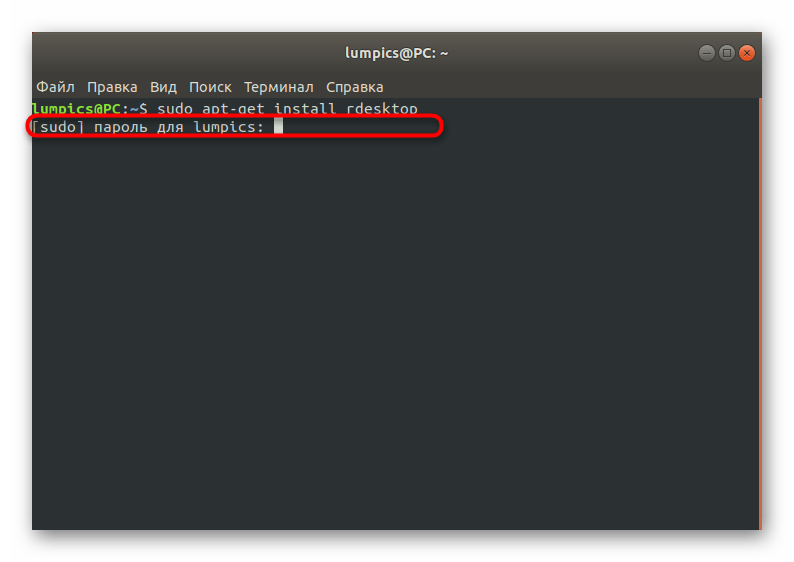
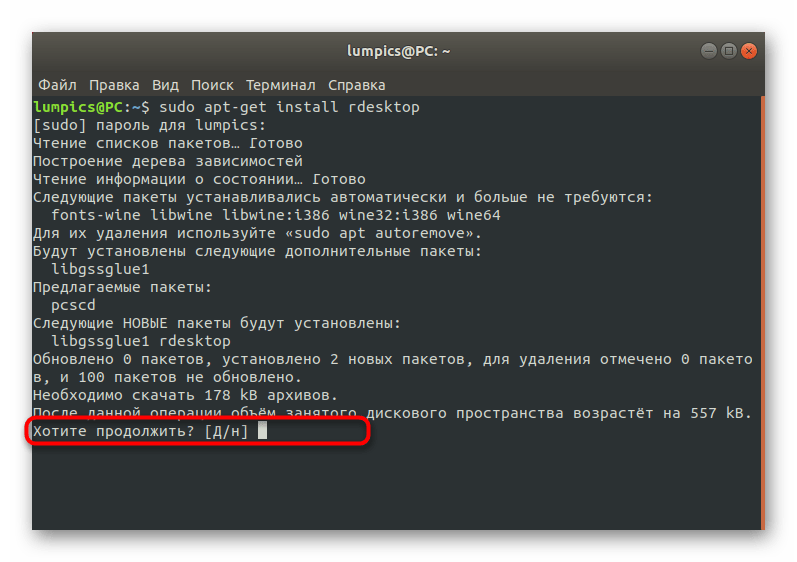
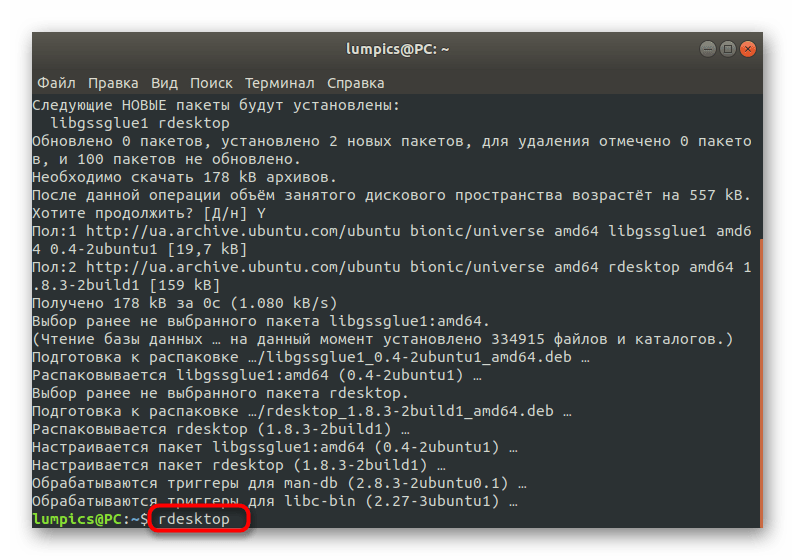
Если используемый дистрибутив основан не на Debian, аргумент apt-get в команде инсталляции придется заменить на yum или pacman. В остальном же никаких различий со сборками Linux не имеется.
Шаг 2: Запуск и подключение
Если в консоли просто вписать команду rdesktop, следующими строками отобразится краткая сводка о синтаксисе и доступных опциях. Мы рекомендуем изучить появившиеся сведения, чтобы понять, как именно осуществляется соединение с удаленным рабочим столом через эту утилиту.

После этого можно осуществлять непосредственное подключение к другому компьютеру. Давайте разберем этот процесс на примере строки rdesktop -z -P -g 1280x900 -u USERNAME -p PASSWORD SERVER_IP.
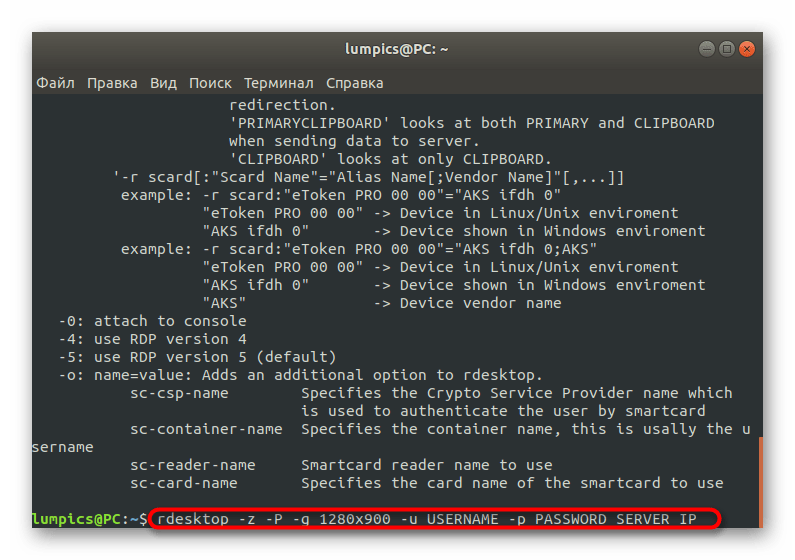
Здесь следует детально рассмотреть абсолютно каждый аргумент и вписываемую информацию.
| Опция | Описание |
|---|---|
| -z | Эта опция отвечает за активацию сжатия потока. Используйте ее для оптимизации соединения. Особенно актуально для систем с низкой скоростью интернета |
| -P | Создает кэширование. Это помогает сохранять некоторую информацию на локальном хранилище, в будущем не обращаясь каждый раз на сервер для ее загрузки |
| -g | Устанавливает пользовательское разрешение окна рабочего стола. После этой опции введите необходимый параметр, чтобы он был применен |
| -u | После этой опции укажите имя пользователя, которое будет отображаться на сервере |
| -p | Данный аргумент необходим в случае присутствия пароля |
| SERVER_IP | Всегда указывается в конце строки. Вместо этой надписи введите доменное имя сервера, к которому хотите осуществить подключение |
Шаг 3: Обмен файлами между Windows и Linux в текущей сессии
В завершение разбора утилиты rdesktop хотим рассказать об основных действия, выполняемых через ввод команд в консоли. Для начала поговорим о самых востребованных задачах, которые связаны с обменом файлов. Сетевая папка подключается через rdesktop -r disk:share=/home/documents -z -P -g 1280x900 -u USERNAME -p PASSWORD SERVER_IP, где все указанные опции и адреса замените на требуемые.
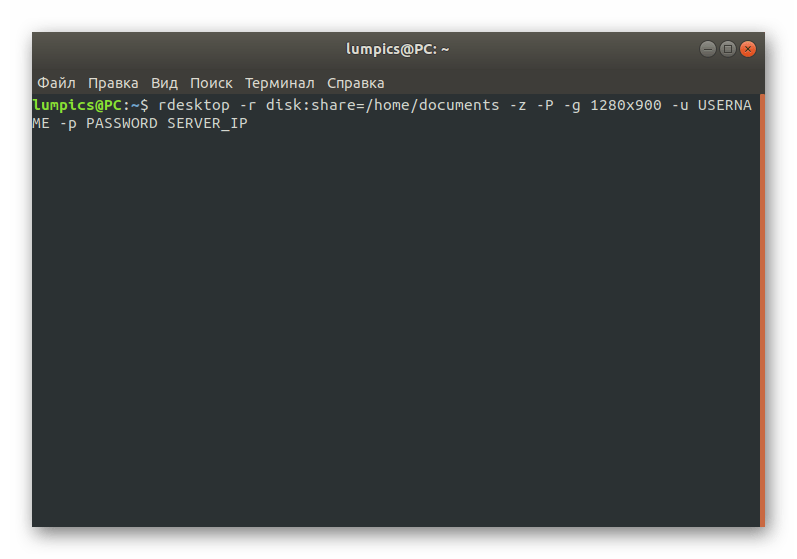
После ввода этой команды папка станет доступна для чтения и записи, что позволит всячески управлять находящимися там файлами. Однако если возникли проблемы с доступом, придется закрыть сессию, активировать команду chown -R /home/documents USERNAME:USERGROUP, а уже потом подключить директорию повторно.
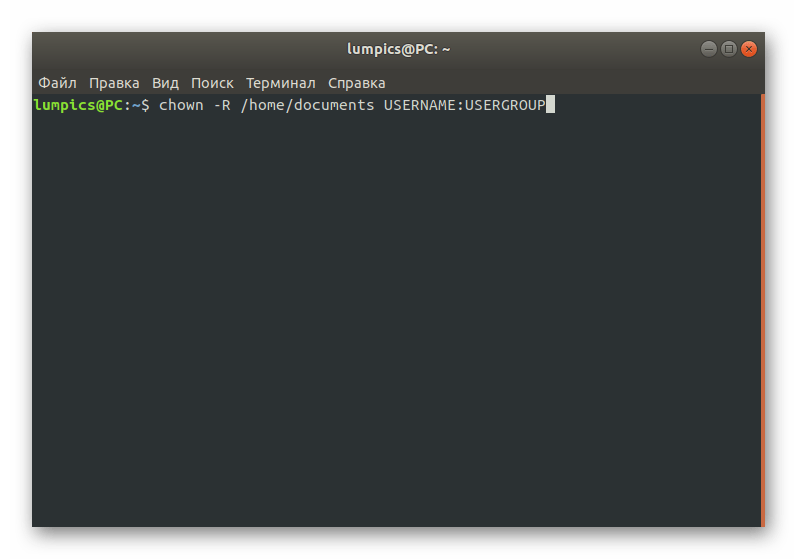
Шаг 4: Создание значка быстрого доступа
При изучении первого RDP-клиента вы могли заметить, что все профили сохраняются в таблице графического меню, что позволяет быстро соединяться и переключаться между ними. К сожалению, в rdesktop такая функция попросту отсутствует, поэтому остается только один альтернативный метод — ручное создание кнопки быстрого доступа для каждого сервера.
- В консоли создайте пустой текстовый файл с произвольным названием через удобный текстовый редактор. Сама команда обретет примерно такой вид:
sudo nano rdesktop, где nano — используемый текстовый редактор, а rdesktop — название самого файла. - При появлении окна вставьте две строки, указанные ниже, заменив опции и сведения о сервере на имеющиеся.
- Сохраните все изменения и завершите работу в текстовом редакторе.
- Введите команду
chmod +x rdesktop, чтобы создать значок быстрого запуска на рабочем столе.
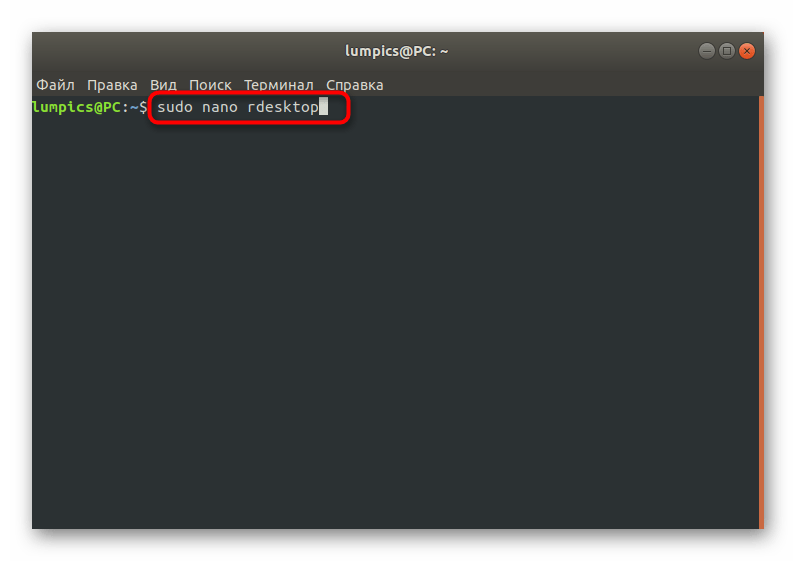
#!/bin/bash
rdesktop -z -P -g 1280x900 -u USERNAME -p PASSWORD SERVER_IP
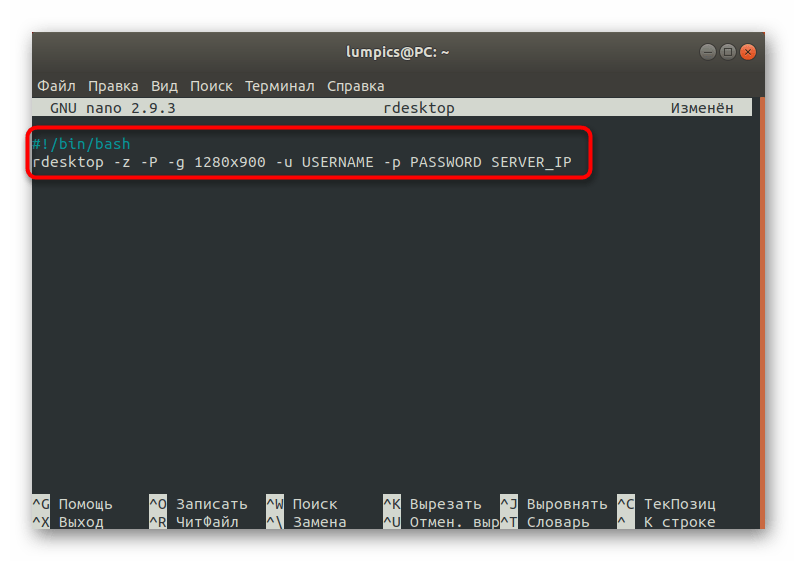
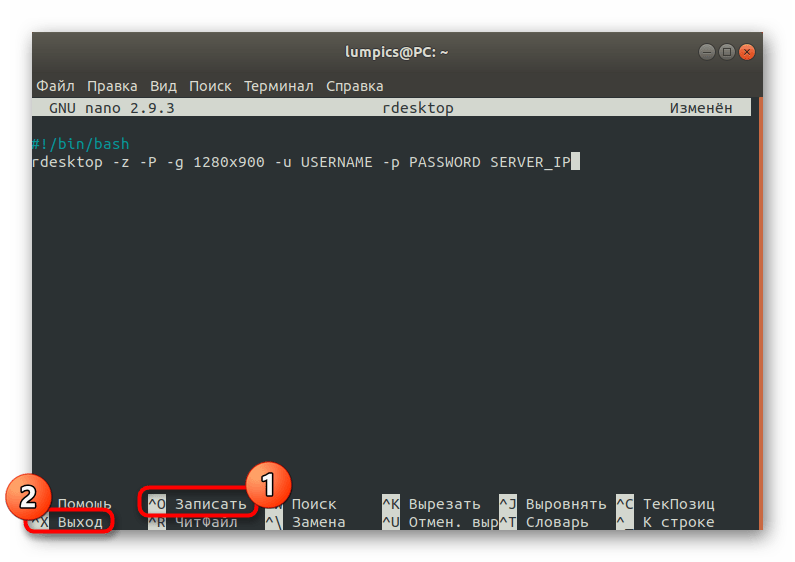
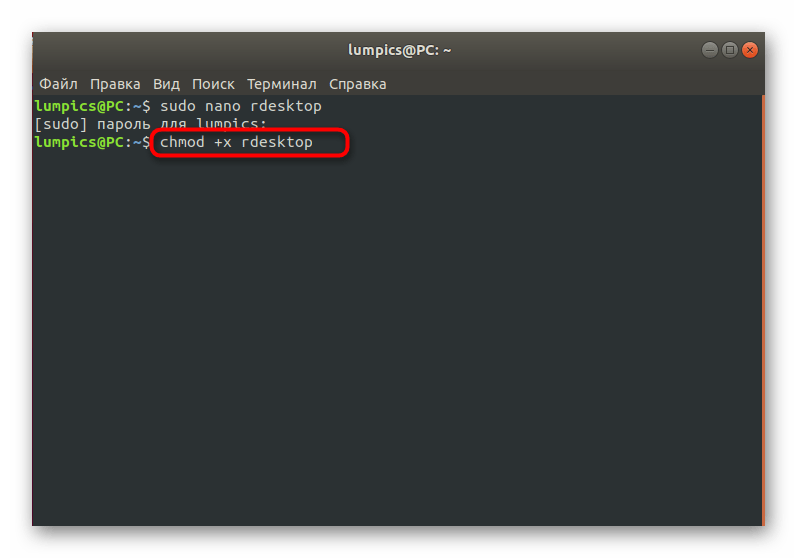
Все остальные опции и нюансы взаимодействия с rdesktop, о которых мы не поговорили выше, детально описаны в официальной документации или используются довольно редко, поэтому и не нуждаются в объяснениях.
Вариант 3: freerdp
freerdp — самый новый из всех известных RDP-клиентов, который только начинает набирать обороты. Управление им тоже осуществляется в консоли, а функций сейчас мало, поэтому мы и поставили этот вариант на последнее место.
- Инсталлируется freerdp со всеми необходимыми компонентами через команду
sudo apt-get install freerdp libfreerdp-plugins-standard. - Инсталляция начнется сразу же после подтверждения паролем.
- Выберите ответ Д, чтобы загрузить все архивы.
- Используйте строку
xfreerdp -u black -d WORK -n "Lumpics" -a 15 -k US -g 1440x830 --plugin cliprdr --plugin rdpdr --data disk:DiskP:/home/black -- my.rdp.server.net, чтобы запустить соединение с сервером.
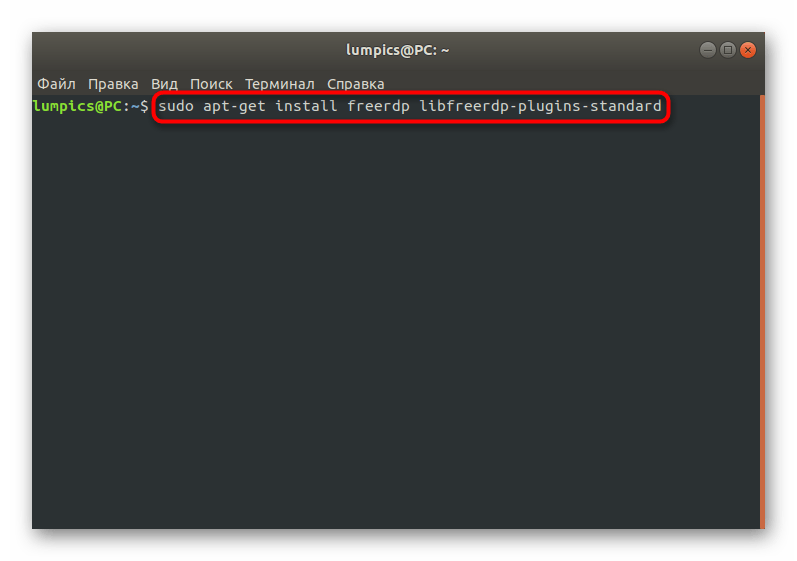
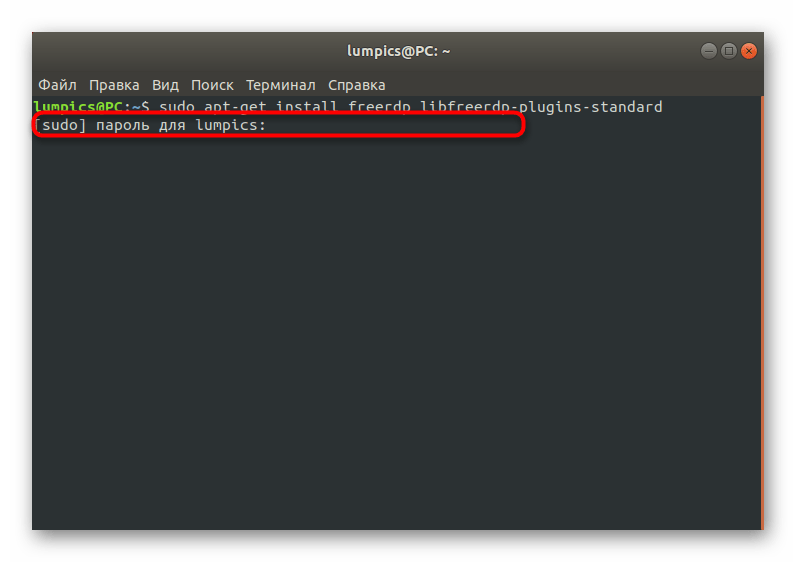
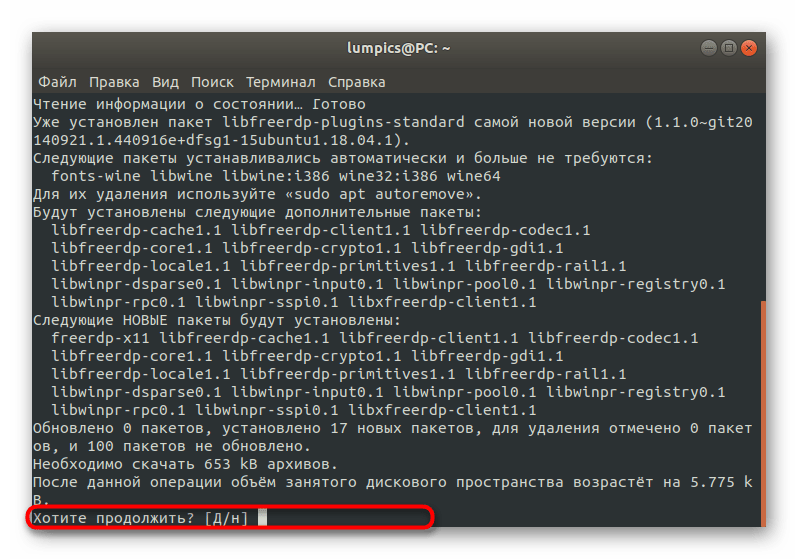
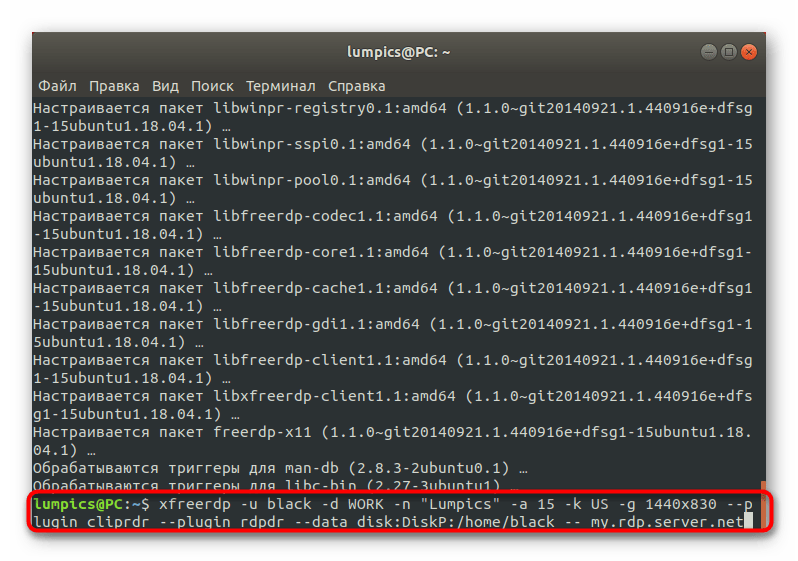
Теперь предлагаем изучить все опции, которые вы увидели в предыдущей строке. Они немного схожи с теми, что применялись во втором варианте при взаимодействии с клиентом rdesktop, но и имеют свои особенности.
| Опция | Описание |
|---|---|
| -u | Отвечает за имя пользователя на сервере. Сразу же после этой опции должен быть вписан соответствующий логин |
| -d | То же самое, но только с доменом рабочей группы, который определяется заранее и должен быть одинаковым у все участников локальной сети |
| -n | Определяет имя хоста |
| -a | После этого аргумента указывается глубина цвета окна. По умолчанию выбирается значение 15 |
| -k | Устанавливает стандартную раскладку клавиатуры, где в качестве параметра указывается код государства |
| -g | Определяет размер отображаемого окна в пикселях |
| —plugin cliprdr | Активирует общий буфер обмена с будущим удаленным рабочим столом |
| —plugin rdpdr —data disk:DiskP:/home/black — | Подключает домашнюю папку как общую сетевую и позволяет обмениваться данными |
| my.rdp.server.net | Заменяется на имя используемого RDP-сервера |
Выше вы получили общую сводку о трех различных RDP-клиентах для Linux. Как видите, все они имеют свои особенности и подойдут разным пользователям. Каждый из них может соединяться с Windows, поэтому вся сложность выбора заключается лишь в различиях управления и реализации графического интерфейса окна показа удаленного рабочего стола.
Наша группа в TelegramПолезные советы и помощь
What is xrdp?
xrdp is an open-source remote desktop protocol (RDP) server that allows users to connect to a Linux desktop environment remotely from a Windows machine. It provides a graphical interface for remote access, making it easier to manage and control a Linux system from a Windows computer.
With xrdp, users can access their Linux Mint machine from anywhere, using a Windows machine as the client. This is particularly useful for users who prefer the Linux environment but need to work on a Windows machine or for those who want to remotely manage their Linux Mint system.
- Open the Terminal
- Update the package lists by running the command:
sudo apt update - Install xrdp by running the command:
sudo apt install xrdp - During the installation process, you may be prompted to enter your password
- Once the installation is complete, xrdp will be automatically started as a service
- By default, xrdp listens on port 3389, which is the standard RDP port
- You may need to configure your firewall to allow incoming connections on port 3389 if it is not already open
- To check the status of the xrdp service, you can use the command:
sudo systemctl status xrdp - If the service is running, you should see a message indicating that it is active and running
- To enable xrdp to start automatically at boot, use the command:
sudo systemctl enable xrdp - To configure xrdp to use a specific desktop environment, you can edit the
/etc/xrdp/startwm.shfile - By default, xrdp uses the Xfce desktop environment. You can change it to use a different desktop environment if desired
- After making any changes to the
startwm.shfile, you will need to restart the xrdp service for the changes to take effect - To restart the xrdp service, use the command:
sudo systemctl restart xrdp
Installing xrdp on Linux Mint is a straightforward process. By following these steps, you can quickly set up xrdp and start using it to remotely access your Linux Mint machine from a Windows computer.
First, open the Terminal on your Linux Mint machine. You can do this by clicking on the Terminal icon in the taskbar or by pressing Ctrl+Alt+T.
Next, update the package lists by running the command sudo apt update. This will ensure that you have the latest information about available packages and their versions.
Once the package lists are updated, you can install xrdp by running the command sudo apt install xrdp. This will download and install the xrdp package along with any necessary dependencies.
During the installation process, you may be prompted to enter your password. This is required to authenticate the installation and make system-level changes.
Once the installation is complete, xrdp will be automatically started as a service. By default, xrdp listens on port 3389, which is the standard RDP port. If your firewall is blocking incoming connections on this port, you may need to configure it to allow connections.
To check the status of the xrdp service, you can use the command sudo systemctl status xrdp. This will display information about the current state of the service, including whether it is active and running.
If the service is running, you should see a message indicating that it is active and running. If it is not running, you can start it manually using the command sudo systemctl start xrdp.
To ensure that xrdp starts automatically at boot, you can enable it as a systemd service using the command sudo systemctl enable xrdp. This will configure the system to start xrdp during the boot process.
By default, xrdp uses the Xfce desktop environment. If you prefer to use a different desktop environment, you can edit the /etc/xrdp/startwm.sh file. This file specifies the command that xrdp uses to start the desktop environment.
After making any changes to the startwm.sh file, you will need to restart the xrdp service for the changes to take effect. You can do this by running the command sudo systemctl restart xrdp.
Connecting to Linux Mint using xrdp
- Once xrdp is installed and configured, you can connect to your Linux Mint machine using a Remote Desktop client on a Windows machine
- Open the Remote Desktop client on your Windows machine
- Enter the IP address or hostname of your Linux Mint machine
- Enter your Linux Mint username and password when prompted
- You should now be able to access your Linux desktop remotely through xrdp
Once xrdp is installed and configured on your Linux Mint machine, you can connect to it using a Remote Desktop client on a Windows machine.
To connect, open the Remote Desktop client on your Windows machine. You can find it by searching for “Remote Desktop” in the Start menu.
In the Remote Desktop client, enter the IP address or hostname of your Linux Mint machine. If you’re not sure what the IP address or hostname is, you can find it by running the command hostname -I in the Terminal on your Linux Mint machine.
After entering the IP address or hostname, click on the “Connect” button to initiate the connection.
You will be prompted to enter your Linux Mint username and password. Enter the credentials and click on the “OK” button to proceed.
If the credentials are correct, you should now be able to access your Linux desktop remotely through xrdp. The Remote Desktop client will display the Linux Mint desktop environment, allowing you to interact with it as if you were sitting in front of the Linux Mint machine.
Conclusion
xrdp is a powerful tool that allows users to remotely access and control a Linux Mint machine from a Windows computer. By following the step-by-step guide outlined in this article, you can easily install and configure xrdp on your Linux Mint machine, enabling remote desktop access. Whether you need to work on a Linux environment from a Windows machine or manage your Linux Mint system remotely, xrdp provides a convenient and user-friendly solution.
FAQs
1. Can I use xrdp to connect to Linux Mint from a Mac?
No, xrdp is primarily designed for connecting to a Linux desktop environment from a Windows machine. However, there are alternative remote desktop solutions available for Mac users, such as VNC (Virtual Network Computing) or SSH (Secure Shell).
2. Can I use xrdp to connect to multiple Linux Mint machines simultaneously?
Yes, xrdp supports multiple concurrent connections. This means that you can connect to multiple Linux Mint machines from a single Windows machine using different instances of the Remote Desktop client.
3. Is xrdp secure?
xrdp uses the Remote Desktop Protocol (RDP) to establish a connection between the client and the server. RDP is a secure protocol that encrypts the data transmitted between the client and the server, providing a secure remote desktop experience. However, it is always recommended to use strong passwords and keep your system up to date with the latest security patches to ensure the highest level of security.
